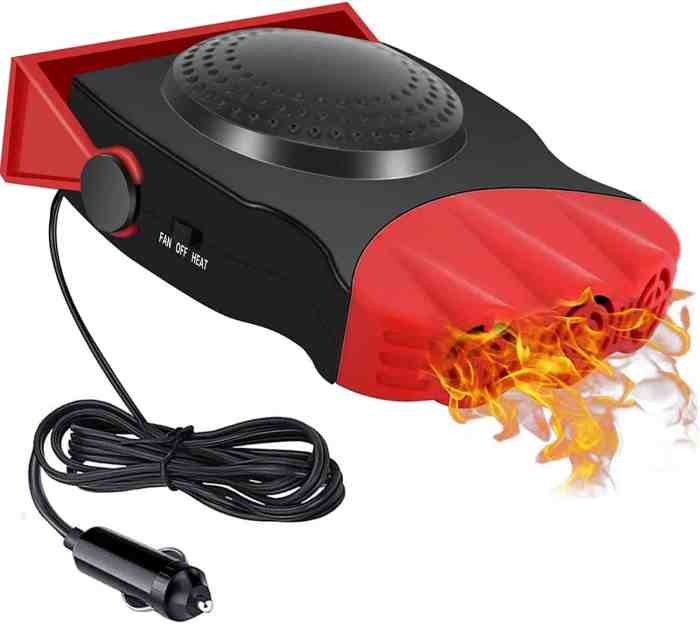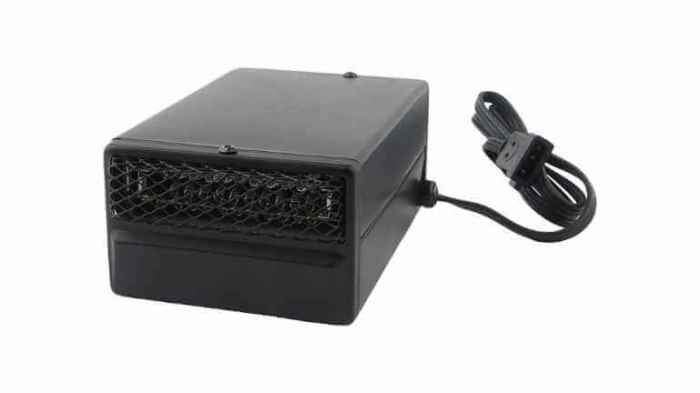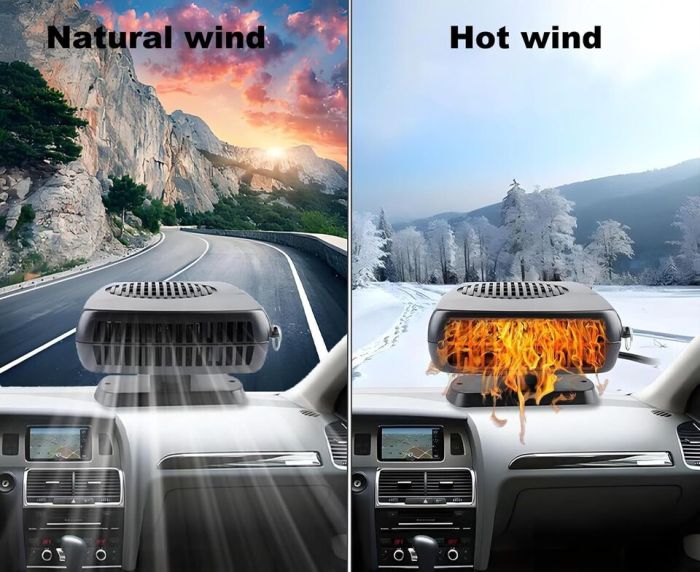Portable car heaters for extreme cold? Yeah, we’ve all been there – shivering in a freezing car, wishing for a little warmth. This isn’t just about comfort; in truly frigid conditions, a portable heater can be a lifesaver. We’re diving deep into the world of these handy devices, exploring different types, safety tips, and how to choose the perfect one for your needs.
From 12V models to propane heaters, we’ll cover it all, ensuring you stay toasty even when Mother Nature throws her coldest punches.
This guide breaks down everything you need to know about staying warm on the road in sub-zero temps. We’ll compare features, discuss safety precautions (because safety first!), and help you figure out which heater is right for your vehicle and your budget. Think of us as your personal winter survival guide, but way less intense (and hopefully a lot warmer).
Types of Portable Car Heaters

Choosing the right portable car heater for extreme cold can be tricky, especially with the variety of options available. Understanding the differences between the main types – 12V, plug-in, and propane – is crucial for making an informed decision that keeps you safe and warm. This section will break down the pros and cons of each, helping you navigate the selection process.
Portable Car Heater Types Comparison
The three main types of portable car heaters each offer distinct advantages and disadvantages. The best choice depends on your specific needs and the conditions you’ll be facing.
| Heater Type | Power Source | Heating Capacity (BTU) | Features | Price Range |
|---|---|---|---|---|
| 12V DC Heater | Car’s 12V DC outlet (cigarette lighter) | Varies greatly, typically 150-500 BTU | Compact, easy to use, readily available. Often includes adjustable fan speeds and thermostat. | $20 – $100 |
| Plug-in Heater (AC) | Standard 120V AC outlet (requires external power source) | Generally higher BTU output than 12V, ranging from 500 to 1500 BTU | Higher heating capacity, ideal for larger vehicles or situations requiring more intense heat. Often more powerful than 12V models. | $30 – $150 |
| Propane Heater | Propane tank | Typically higher BTU output, ranging from 4000 to 9000 BTU or more | Powerful heating capacity, independent of vehicle’s electrical system. Can be used for extended periods in remote locations. Requires proper ventilation. | $100 – $300+ |
Advantages and Disadvantages of Each Type
Let’s delve into the specific pros and cons of each heater type in extreme cold.
12V DC Heater
Advantages: Convenience and portability are key. They are readily available, easy to use, and plug directly into your car’s power outlet. They are also generally inexpensive.Disadvantages: Limited heating capacity. They struggle to significantly warm larger vehicles or those exposed to extremely low temperatures. Overuse can drain your car battery.
Plug-in Heater (AC)
Advantages: Higher heating capacity than 12V heaters. They are suitable for larger vehicles and more effectively combat extreme cold.Disadvantages: Requires access to an external power source, limiting its portability. You can’t use it in remote areas without a generator or alternative power supply.
Seriously, battling extreme cold in your car? Portable car heaters are a lifesaver, but staying warm also means having a killer sound system. Check out the best options if you’re looking for an upgrade, like those listed in this article on Best Android Auto head units under $300 , to keep you entertained while you thaw out.
Then you can crank up the tunes and enjoy the warmth of your portable heater.
Propane Heater
Advantages: Highest heating capacity. Propane heaters provide powerful heat, ideal for extreme cold and remote locations, independent of your vehicle’s electrical system.Disadvantages: Requires a propane tank, adding weight and requiring refills. They require careful ventilation to avoid carbon monoxide poisoning, posing a safety concern if not used properly. They are also typically more expensive.
Portable Car Heater Selection Flowchart
Imagine a flowchart. The starting point is “Need a Portable Car Heater?”. Yes leads to a diamond decision point: “Vehicle Size & Cold Exposure?”.If the vehicle is small and exposure to cold is mild, the path leads to “12V DC Heater”. If the vehicle is large or exposure to cold is extreme, the path leads to another diamond decision point: “Access to External Power?”.If yes, the path leads to “Plug-in Heater (AC)”.
If no, the path leads to “Propane Heater”. Each terminal point represents the recommended heater type. The flowchart visually guides the user through a decision-making process based on their specific needs and circumstances.
Safety Considerations for Portable Car Heaters
Portable car heaters can be lifesavers in frigid conditions, but they also present significant safety risks if not used and maintained correctly. Improper use can lead to anything from minor inconveniences to serious injury or even death. Understanding these risks and following safety protocols is crucial for preventing accidents.The primary concern with portable car heaters is the risk of carbon monoxide poisoning.
These heaters burn fuel, and incomplete combustion can release deadly carbon monoxide (CO) gas, an odorless, colorless, and tasteless gas that can quickly lead to unconsciousness and death. Furthermore, the heaters themselves can pose fire hazards if malfunctioning or improperly placed near flammable materials. Overheating, electrical shorts, and fuel leaks are all potential sources of ignition. In addition, the intense heat produced by these devices can cause burns if touched directly or if materials come into contact with the heater.
Carbon Monoxide Poisoning Prevention
Carbon monoxide poisoning is a severe risk associated with portable car heaters, especially in poorly ventilated spaces. CO builds up rapidly in enclosed areas, displacing oxygen and causing symptoms such as headache, dizziness, nausea, and weakness. Prolonged exposure can lead to loss of consciousness, brain damage, and death. Even small amounts of CO can be dangerous, and symptoms can be subtle, making early detection difficult.
To prevent CO poisoning, proper ventilation is absolutely paramount.
Safe Operation and Maintenance Guidelines
Safe and responsible use of a portable car heater requires careful attention to detail and adherence to manufacturer instructions. Negligence can quickly turn a helpful device into a dangerous one. The following guidelines should always be followed:
- Always operate the heater in a well-ventilated area. Never use it in an enclosed space without adequate airflow.
- Regularly inspect the heater for any signs of damage, such as cracks, frayed wires, or fuel leaks. Do not use a damaged heater.
- Ensure the heater is placed on a stable, level surface away from flammable materials such as upholstery, clothing, or paper products.
- Never leave the heater unattended while operating. Turn it off and unplug it when leaving the vehicle.
- Follow the manufacturer’s instructions carefully regarding fuel type, filling procedures, and maintenance.
- Install and use a CO detector in your vehicle if you frequently use a portable car heater.
- Never modify or attempt to repair the heater yourself. Contact a qualified technician for any repairs.
Importance of Proper Ventilation
Adequate ventilation is critical for preventing carbon monoxide poisoning and other safety hazards. Insufficient ventilation allows CO to accumulate, creating a dangerous environment. For example, using a portable heater in a completely sealed car with the windows and doors closed is extremely dangerous and can lead to rapid CO buildup, potentially resulting in unconsciousness or death within minutes.
Similarly, using a heater in a vehicle with a faulty or blocked ventilation system can also lead to dangerous CO levels. The consequences of inadequate ventilation can range from mild headaches to severe illness and even death. Always ensure fresh air circulation by slightly cracking a window or using the vehicle’s ventilation system.
Seriously, battling sub-zero temps in your car? A portable heater is a lifesaver, but don’t forget about proper tire pressure! Maintaining optimal inflation is key for safety and fuel efficiency, so check it regularly with a good gauge – like the ones you can find on sale at Discount tire pressure gauges 2025. Proper tire pressure will help your car handle better, which is super important when driving in icy conditions, especially when you’re already relying on a portable heater for warmth.
Effectiveness in Extreme Cold
Portable car heaters can be lifesavers in extreme cold, but their effectiveness varies significantly depending on several factors. Understanding these factors is crucial for choosing the right heater and ensuring your safety in sub-zero temperatures. This section explores the performance differences between various heater types in extreme cold and how to determine the appropriate heating capacity for your vehicle.
The heating performance of portable car heaters in extreme cold (-20°C and below) is dramatically affected by both the heater’s specifications and the environmental conditions. While some heaters might advertise impressive wattage, their actual heating output can fall short in severely cold environments due to factors like reduced efficiency at low temperatures and heat loss from the vehicle itself.
The size and insulation of your vehicle play a significant role; a larger, well-insulated SUV will require a less powerful heater to maintain a comfortable temperature compared to a smaller, poorly insulated car.
Heating Performance Comparison in Extreme Cold
The following table compares the estimated heating performance of different portable car heater types in -20°C conditions. These are estimates based on average performance data and may vary depending on specific models and environmental factors. Always consult the manufacturer’s specifications for your particular heater.
| Heater Type | Wattage (Typical) | Estimated Temperature Increase (Small Car, Poor Insulation) | Estimated Temperature Increase (Large SUV, Good Insulation) |
|---|---|---|---|
| 12V Fan Heater | 150W | Minimal, may only slightly offset heat loss | Slight increase, may not be sufficient for comfort |
| 12V Ceramic Heater | 300W | Moderate increase, may reach a tolerable temperature | Comfortable temperature increase, likely sufficient |
| 12V Air Parking Heater (Diesel) | 5000W | Significant increase, capable of reaching a comfortable temperature | Rapid and substantial temperature increase, maintains comfort easily |
Factors Influencing Heater Effectiveness
Several factors beyond the heater’s wattage influence its effectiveness in extreme cold. Understanding these factors helps you choose the right heater and manage expectations.
Vehicle insulation plays a crucial role. A vehicle with poor insulation will lose heat much faster than a well-insulated one. This means a more powerful heater will be needed to maintain a comfortable temperature. Ambient temperature also significantly impacts effectiveness. The lower the outside temperature, the harder the heater has to work to counteract heat loss.
Calculating Required Heating Capacity
Precisely calculating the required heating capacity is complex and depends on numerous variables. However, a simplified approach can provide a reasonable estimate. This involves considering the vehicle’s volume (larger vehicles require more heating), the desired temperature increase, the vehicle’s insulation quality (rated R-value if available), and the ambient temperature.
A rough estimation can be done using the following formula: Required heating capacity (Watts) ≈ (Vehicle Volume (cubic meters)
– Desired Temperature Increase (°C)
– Heat Capacity of Air (approximately 1.2 J/m³°C)) / Time (hours).
This is a simplified formula and doesn’t account for all factors like heat loss through windows, doors, and the vehicle’s overall thermal efficiency. It serves as a starting point for determining an approximate wattage requirement. Consult professional advice for more accurate calculations.
For example, to heat a small car (approximately 3 cubic meters) by 10°C in 1 hour, with minimal insulation, the estimated required wattage would be: (3 m³
– 10°C
– 1.2 J/m³°C) / 1 hour ≈ 36 J/s = 36 Watts. This is a very basic estimate, and a much higher wattage would likely be needed in practice to compensate for heat loss.
This illustrates the importance of choosing a heater with sufficient capacity for your specific vehicle and climate.
Features and Benefits of Advanced Models
Stepping up from basic portable car heaters, advanced models offer a range of features designed for enhanced safety, comfort, and efficiency, particularly crucial in extreme cold conditions. These features go beyond simple heating and provide a more refined and reliable warming experience. The differences can significantly impact your comfort and safety during a cold-weather emergency or extended stay in a vehicle.Advanced portable car heaters boast several key features that set them apart from standard models.
These features enhance safety, improve user experience, and optimize heating performance in challenging environments. Understanding these differences can help you choose the right heater for your needs.
Safety Features in Advanced Portable Car Heaters
Advanced portable car heaters prioritize safety through features like automatic shutoff mechanisms and overheat protection. Automatic shutoff engages if the heater tips over, preventing potential fires or burns. Overheat protection ensures the heater automatically shuts down if it reaches a dangerously high internal temperature, safeguarding against malfunctions. These features are absent in many standard models, making them significantly riskier in situations where unattended operation might be necessary.
For example, if you need to leave the heater running while you briefly leave your car, the automatic shutoff and overheat protection provide peace of mind.
Temperature Control and Efficiency Enhancements
Many advanced models offer variable temperature control, allowing users to precisely adjust the heat output to their comfort level. This contrasts with standard models, which often only offer a single high-heat setting. Variable temperature control is beneficial for energy conservation and preventing overheating. Imagine being able to fine-tune the heat to a comfortable level instead of enduring blasts of intense heat or struggling with insufficient warmth.
This feature also allows for gradual warming, preventing sudden temperature shocks. Furthermore, some advanced models incorporate ceramic heating elements or other technologies that increase efficiency and reduce energy consumption, leading to longer run times and reduced fuel costs.
Comparison of Advanced and Standard Models
The following table summarizes the key differences between advanced and standard portable car heaters:
| Feature | Advanced Model | Standard Model |
|---|---|---|
| Automatic Shutoff | Present (tip-over and overheat) | Absent or limited |
| Overheat Protection | Present | Absent |
| Temperature Control | Variable, precise adjustment | Single high-heat setting |
| Heating Element | Ceramic or other efficient technology | Often less efficient resistive wire |
| Safety Certifications | Usually multiple safety certifications | Fewer or less stringent certifications |
The Ideal Portable Car Heater for Extreme Cold
The ideal portable car heater for extreme cold would combine all the advanced features mentioned above, plus some additional enhancements. It would feature a robust, high-output heating element capable of quickly warming even a large vehicle in sub-zero temperatures. Its design would prioritize safety with multiple redundant safety mechanisms, including automatic shutoff, overheat protection, and potentially a thermal fuse as an additional layer of security.
The heater would include a digital display with precise temperature control, allowing users to set and monitor the temperature easily. For added convenience, it would operate quietly and efficiently, minimizing noise and energy consumption. Finally, it would be constructed from durable, weather-resistant materials to withstand harsh conditions. This hypothetical heater represents the pinnacle of portable car heating technology, providing both powerful warmth and unparalleled safety in extreme cold environments.
A real-world example approaching this ideal might be a high-end model with features like a PTC ceramic heating element, multiple safety sensors, and a digital thermostat.
Installation and Usage

Portable car heaters offer a crucial layer of comfort and safety during frigid winter conditions. However, their effectiveness hinges on correct installation and proper usage. Understanding these aspects is vital for maximizing their benefits and avoiding potential hazards.
Installing Different Types of Portable Car Heaters
Different portable car heaters require slightly different installation procedures. Generally, these heaters are designed for plug-and-play convenience, minimizing the need for extensive installation.
- 12V Plug-in Heaters: These are the most common type. Simply plug the heater’s DC power cord into your vehicle’s 12V power outlet (cigarette lighter). Ensure the outlet is functioning correctly and the cord is securely plugged in. Avoid overloading the outlet with multiple devices.
- Block Heaters (Engine Block Heaters): These heaters require a more involved installation. First, consult your vehicle’s owner’s manual to locate the appropriate engine block coolant port. Then, carefully attach the heater’s cord to this port, following the manufacturer’s specific instructions. This usually involves removing a hose clamp, inserting the heater, and re-securing the clamp. Finally, plug the heater into a grounded outdoor outlet.
- Propane Heaters: These heaters require careful attention to safety regulations. Ensure proper ventilation is available within the vehicle, and never use them in enclosed spaces without adequate airflow. Connect the propane tank securely to the heater, following the manufacturer’s instructions. Then turn the heater on, following the operational instructions carefully. Always check for leaks before operation.
Using Portable Car Heaters Safely and Effectively
Safe and effective operation of a portable car heater is paramount. Always follow the manufacturer’s instructions carefully, paying close attention to safety warnings.
- Never leave a running heater unattended. This is crucial for all types of heaters, especially those that use propane or other fuels.
- Ensure adequate ventilation. Carbon monoxide poisoning is a serious risk with some types of heaters. Crack a window slightly to allow for fresh air circulation.
- Monitor the heater’s temperature. Avoid setting the temperature too high, as this can damage the heater or create a fire hazard.
- Inspect the power cord and connections regularly. Look for any signs of damage or wear, and replace the cord if necessary.
- Always turn off the heater before exiting the vehicle. This prevents accidental burns or fire hazards.
Maintaining Portable Car Heaters, Portable car heaters for extreme cold
Regular maintenance extends the lifespan and performance of your portable car heater.
Cleaning is a key aspect of maintenance. For 12V plug-in heaters, simply wipe down the exterior with a damp cloth. For other types, consult the manufacturer’s instructions for specific cleaning recommendations. Always disconnect the heater from the power source before cleaning. Storage is also important; store the heater in a cool, dry place when not in use, protecting it from moisture and extreme temperatures.
For propane heaters, ensure the propane tank is stored separately, following all safety regulations.
Troubleshooting Common Issues
Problems can arise with portable car heaters. A quick troubleshooting guide can help resolve most common issues.
| Problem | Possible Cause | Solution |
|---|---|---|
| Heater not working | Power cord not plugged in securely; blown fuse; faulty heater; dead battery | Check power cord and connections; check and replace fuse if necessary; check the heater’s internal components or contact a repair service; check and charge vehicle battery. |
| Heater not heating sufficiently | Low voltage; blocked air vents; thermostat setting too low; faulty heating element | Check vehicle’s electrical system; clear any obstructions from the air vents; adjust the thermostat; contact a repair service. |
| Unusual noises or smells | Loose parts; overheating; malfunctioning components | Inspect the heater for loose parts; check for overheating; contact a repair service. |
| Propane heater won’t ignite | Empty propane tank; faulty ignition system; low propane pressure | Replace propane tank; contact a repair service; check propane tank pressure. |
Illustrative Examples
Portable car heaters are more than just a convenience; in extreme cold, they can be lifesavers. The following scenarios highlight their crucial role in ensuring safety and well-being during unexpected situations and demanding work environments.
Scenarios Demonstrating the Value of Portable Car Heaters
Let’s examine three distinct situations where a portable car heater proves invaluable in preventing hypothermia and ensuring survival in freezing temperatures. These examples illustrate the heater’s practical application across various circumstances.
Stranded Motorist
Imagine a blizzard raging across a remote highway. A driver experiences a sudden mechanical failure, leaving them stranded in sub-zero temperatures with a failing vehicle battery. Their cell phone battery is also low, limiting communication options. A portable car heater, plugged into a 12V outlet, provides a crucial source of warmth, preventing hypothermia while they wait for rescue.
The small, compact heater’s consistent heat output helps maintain a survivable cabin temperature, offering a critical lifeline until help arrives. The outcome is a significantly increased chance of survival, thanks to the heater’s ability to combat the life-threatening cold.
Emergency Vehicle
Ambulances and other emergency vehicles often face extended waits at accident scenes in harsh winter conditions. Paramedics and other first responders may need to remain inside the vehicle for extended periods, tending to patients or awaiting transport. A portable car heater provides supplemental warmth, maintaining a comfortable and safe environment for both the crew and any injured individuals.
This prevents the chilling effect of prolonged exposure to extreme cold, ensuring optimal performance and minimizing risk of hypothermia among the emergency responders themselves. The outcome is a more efficient and safer emergency response, especially in prolonged situations.
Outdoor Worker
Consider a construction worker or utility lineman working in extremely cold conditions, such as repairing power lines during a winter storm. Their vehicle serves as a temporary refuge between work periods. A portable car heater allows them to warm up quickly, preventing fatigue and reducing the risk of frostbite or hypothermia. The ability to quickly regain body temperature significantly improves their ability to continue working safely and efficiently.
The outcome is increased worker productivity and reduced risk of cold-related injuries.
Appearance of a High-Quality Portable Car Heater
A high-quality portable car heater typically resembles a compact, rectangular unit, approximately the size of a small microwave oven. It’s usually constructed from durable, heat-resistant plastic with a metallic grill covering the heating element for safety. The control panel, often located on the top, features clear, easy-to-use buttons or knobs for adjusting temperature and fan speed. A bright LED display shows the current settings.
The power cord is typically a heavy-duty, coiled 12V cord designed for automotive use, featuring a robust connector and often incorporating a fuse for additional safety. Many models include an automatic shutoff feature as a safety precaution against overheating.
Sound of a Typical Portable Car Heater During Operation
A typical portable car heater produces a low hum during operation, similar to a small fan. While audible, the sound is generally not considered loud or disruptive, especially when compared to the noise of a running engine. High-quality models are designed to minimize noise, focusing on efficient heating rather than generating excessive sound. Unusual noises, such as rattling or clicking, would indicate a potential problem and warrant inspection.
Final Summary: Portable Car Heaters For Extreme Cold

So, there you have it – a comprehensive look at portable car heaters for extreme cold. From understanding the different types and their pros and cons to mastering safe operation and choosing the right model for your needs, we’ve covered the essentials. Remember, staying warm in freezing conditions isn’t just about comfort; it’s about safety. By understanding the potential hazards and following the safety guidelines, you can enjoy the warmth and peace of mind that a portable car heater provides.
Now go forth and conquer those icy roads!









